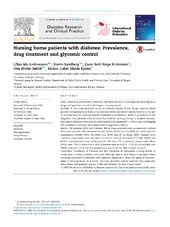| dc.contributor.author | Andreassen, Lillan Mo | en_US |
| dc.contributor.author | Sandberg, Sverre | en_US |
| dc.contributor.author | Kristensen, Gunn Berit Berge | en_US |
| dc.contributor.author | Sølvik, Una Ørvim | en_US |
| dc.contributor.author | Kjome, Reidun Lisbet Skeide | en_US |
| dc.date.accessioned | 2014-12-08T13:21:28Z | en_US |
| dc.date.accessioned | 2014-12-09T08:36:12Z | en_US |
| dc.date.accessioned | 2014-12-10T10:09:14Z | |
| dc.date.available | 2014-12-10T10:09:14Z | |
| dc.date.issued | 2014-04-28 | eng |
| dc.identifier.issn | 0168-8227 | |
| dc.identifier.uri | https://hdl.handle.net/1956/8880 | |
| dc.description.abstract | Aims: Determine prevalence of diabetes, and describe use of blood glucose lowering (BGL) drugs and glycemic control in Norwegian nursing homes. Methods: In this cross-sectional study we collected details of BGL drugs, capillary blood glucose measurements (CBGM) in the last four weeks and HbA1c measurements in the last 12 months from the medical records of patients with diabetes, within a population of 742 long-term care patients from 19 randomly selected nursing homes in Western Norway. Descriptive statistics were applied, and Pearson’s chi-squared (P 0.05) or non-overlapping 95% confidence intervals were interpreted as significant effects. Results: 116 patients (16%) had diabetes, 100 of these gave informed consent and medical data were available. BGL treatment was as follows: (1) insulin only (32%), (2) insulin and oral antidiabetics (OADs) (15%), (3) OADs only (27%) and (4) no drugs (26%). Patients with cognitive impairment were less likely to receive medical treatment (P = 0.04). CBGM and HbA1c measurements were performed for 73% and 77% of patients, respectively. Mean HbA1c was 7.3% (57 mmol/mol), 46% of patients had an HbA1c <7.0% (53 mmol/mol), and CBGM consistent with risk of hypoglycemia was found for 60% of these patients. Conclusions: Prevalence of diabetes and BGL treatment in Norwegian nursing homes is comparable to other European countries. Although special care seems to be taken when choosing treatment for patients with cognitive impairment, there are signs of overtreatment in the population as a whole. The strict glycemic control unveiled may negatively affect these frail patients’ quality of life and increase the risk of early death. | en_US |
| dc.language.iso | eng | eng |
| dc.publisher | Elsevier | eng |
| dc.rights | Attribution-NonCommercial-ShareAlike CC BY-NC-SA | eng |
| dc.rights.uri | http://creativecommons.org/licenses/by-nc-sa/3.0/ | eng |
| dc.subject | Diabetes | eng |
| dc.subject | Nursing homes | eng |
| dc.subject | Drug therapy | eng |
| dc.subject | Glycemic control | eng |
| dc.title | Nursing home patients with diabetes: Prevalence, drug treatment and glycemic control | en_US |
| dc.type | Peer reviewed | |
| dc.type | Journal article | |
| dc.date.updated | 2014-12-08T13:21:29Z | en_US |
| dc.description.version | publishedVersion | en_US |
| dc.rights.holder | Copyright 2014 The Authors | |
| dc.identifier.doi | https://doi.org/10.1016/j.diabres.2014.04.012 | |
| dc.identifier.cristin | 1151673 | |
| dc.source.journal | Diabetes Research and Clinical Practice | |
| dc.source.40 | 105 | |
| dc.source.14 | 1 | |
| dc.source.pagenumber | 102-109 | |
| dc.subject.nsi | VDP::Medical sciences: 700::Health sciences: 800::Nursing science: 808 | eng |
| dc.subject.nsi | VDP::Medisinske fag: 700::Helsefag: 800::Sykepleievitenskap: 808 | nob |

